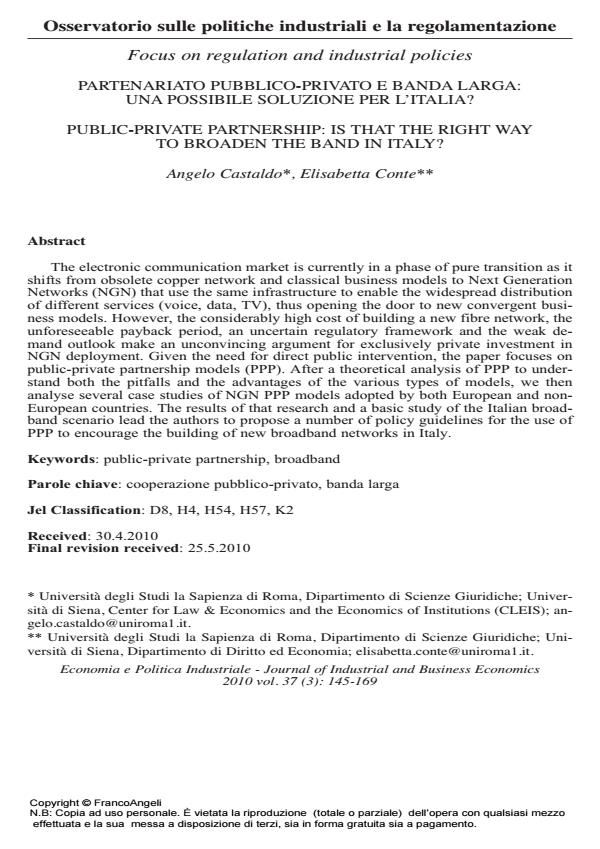Public-private partnership: is that the right way to broaden the band in Italy?
Journal title ECONOMIA E POLITICA INDUSTRIALE
Author/s Angelo Castaldo, Elisabetta Conte
Publishing Year 2010 Issue 2010/3
Language Italian Pages 25 P. 145-169 File size 463 KB
DOI 10.3280/POLI2010-003007
DOI is like a bar code for intellectual property: to have more infomation
click here
Below, you can see the article first page
If you want to buy this article in PDF format, you can do it, following the instructions to buy download credits

FrancoAngeli is member of Publishers International Linking Association, Inc (PILA), a not-for-profit association which run the CrossRef service enabling links to and from online scholarly content.
The electronic communication market is currently in a phase of pure transition as it shifts from obsolete copper network and classical business models to Next Generation Networks (NGN) that use the same infrastructure to enable the widespread distribution of different services (voice, data, TV), thus opening the door to new convergent business models. However, the considerably high cost of building a new fibre network, the unforeseeable payback period, an uncertain regulatory framework and the weak demand outlook make an unconvincing argument for exclusively private investment in NGN deployment. Given the need for direct public intervention, the paper focuses on public-private partnership models (PPP). After a theoretical analysis of PPP to understand both the pitfalls and the advantages of the various types of models, we then analyse several case studies of NGN PPP models adopted by both European and non- European countries. The results of that research and a basic study of the Italian broadband scenario lead the authors to propose a number of policy guidelines for the use of PPP to encourage the building of new broadband networks in Italy.
Keywords: Public-private partnership, broadband
Jel codes: D8, H4, H54, H57, K2
- Measuring (in a time of crisis) the impact of broadband connections on economic growth: an OECD panel analysis Angelo Castaldo, Alessandro Fiorini, Bernardo Maggi, in Applied Economics /2018 pp.838
DOI: 10.1080/00036846.2017.1343448 - Public Private Partnerships P. O. Achard, pp.261 (ISBN:978-3-030-24599-3)
- Unlocking the potential of Italian broadband: Case studies and policy lessons Alberto Nucciarelli, Angelo Castaldo, Elisabetta Conte, Bert Sadowski, in Telecommunications Policy /2013 pp.955
DOI: 10.1016/j.telpol.2013.05.008
Angelo Castaldo, Elisabetta Conte, Partenariato pubblico-privato e banda larga: una possibile soluzione per l'Italia? in "ECONOMIA E POLITICA INDUSTRIALE " 3/2010, pp 145-169, DOI: 10.3280/POLI2010-003007